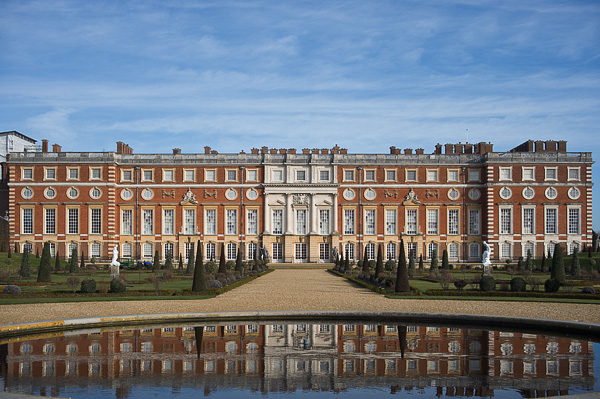Large Format Camera Alignment - I
23/01/11 12:00

Hampton Court (South elevation) photographed with a conventional digital SLR
© Guy Montagu-Pollock
Few photographers worry about mechanical alignment because most cameras are engineered so the axis of the lens is always perpendicular to the image plane. Focus and zoom, which are along the lens axis, and easily arranged with helical threads and rails.
Technical cameras are different because the lens and the film plane can be moved in all three axes (extension, shift and rise) and rotated in two (tilt and swing). Photographers exploit these movements for effect, but this very flexibility means they need to spend time and skill to ensure everything is perfectly square when they need it to be.
Why is it important?
Technical cameras are popular with architectural photographers. Although their complex movements can be used creatively, photographers are often faced with the classic axial elevation (see above) which must be sharp from edge to edge. This requires the image plane to be parallel to the subject, and the lens axis to be perpendicular to the film plane. Any discrepancy and the building’s facade will lose sharpness up or down or from side to side.
Why has this suddenly become a problem?
The problem has always been there, but digital editing and manipulation means we examine photographs in increasingly finer detail, making the problem more apparent. Traditionally, technical cameras used large format plates or film that might be 5x4” or 10x8” in size. Sharpness was checked with the naked eye or a magnifying loupe. A decent sized print could be made with relatively little enlargement so minor optical aberration passed unnoticed.
For example: a powerful loupe has 10x magnification. A huge wall print measuring 5x4 feet has 12x magnification from 5x4” film, or 6x from 10x8”. With a digital back, critical sharpness will be checked on screen at 100%, which is a magnification of 40x-65x (based on currently available products). It is no wonder that all kinds of problems are being noticed.
Why not stop down?
In practice, most compositions require more than just the subject to be in focus and the photographer will stop down, or close the aperture iris, to achieve greater depth of field. This makes near and far objects appear sharper, and this increased tolerance will swallow small inaccuracies with alignment, too. However, an optical phenomenon known as diffusion makes the image fuzzier as the iris becomes smaller, so more things may be in focus, but the sharpest object will be less sharp than at wide open aperture. Contrary to popular belief, it is possible to stop down too much: instead, it must be a compromise between ultimate sharpness and acceptable sharpness overall.
Again, with large format film, magnification was low, therefore the side effects of small apertures were not obvious. Many photographers thought nothing of stopping down to f/45 or f/64 (see Group f/64, founded by Ansel Adams). Checking quality the way we do with digital photography, images become unacceptably muzzy beyond quite modest limits. With a 35MM sized sensor that might be between f/11-16, and with a medium format digital back, perhaps f/16-22, but it also depends on the focal length of the lens.
The fact is that digital photography has caused a reversal of technical priorities in the field. With film, especially transparency film, one had to be absolutely spot on the right exposure, and mistakes were costly, but one could be relatively casual about focusing as long as one stopped down far enough. With digital photography, one can be quite blazé about initial exposure, indeed correcting from the on-screen histogram becomes part of the process, but without being able to stop down so far for depth of field, focusing accuracy has become super critical.